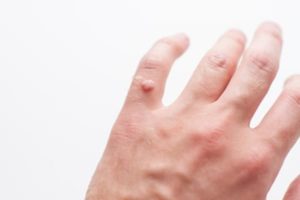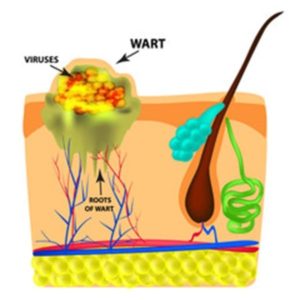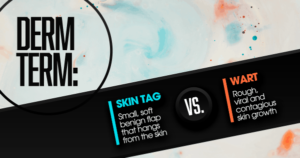Warts occur when skin cells grow faster than normal because they are infected with a strain from the human papillomavirus (HPV) family. About 10 of the 150 strains of HPV cause skin warts, including common, plantar (foot), and flat warts. Anyone can get them, but kids get them more often. Here’s what to do about warts.
Types of Warts
There are different kinds of warts, determined by where it grows on the body and what it looks like. The following describes the signs and symptoms of some of the different types of warts:

- Common warts (also called verruca vulgaris) have these traits:
- Grow most often on the fingers, around the nails, and on the backs of the hands.
- Are more common where the skin is broken, such as biting fingernails or picking at hangnails.
- Can have black dots that look like seeds (often called “seed” warts).
- Most often feel like rough bumps.
- Foot warts (also called plantar warts) have these traits:
- Grow most often on the soles (plantar surface) of the feet
- It can hurt; it feels like you have pebbles in your shoe
- Can have black dots

- Flat warts have these traits:
- It can occur anywhere. Children usually get them on the face. Men often get these in the beard area, and women tend to get them on their legs.
- Tend to grow in large numbers, 20 to 100 at a time.
- Filiform warts have these traits:
- It looks like long threads or thin fingers that stick out
- Often grows on the face: around the mouth, eyes, and nose
- Often grow quickly
Why Do Kids Get Warts More Often?
HPV viruses are like other germs. The wart virus loves warm, moist places like minor cuts or scratches on your hands or feet. Once the virus finds a nice warm place on the skin, a wart begins to develop. Warts can grow for many months — sometimes a year or more — before they are big enough to see.

If you touch a towel, surface, or anything else someone with a wart has used, you can pick up HPV. Kids who bite their fingernails or pick at hangnails get warts more often than kids who don’t. Kids are always getting scrapes or bumps, so playgrounds, gyms, and daycares can be high transmission locations for warts if not properly sanitized. That’s why it’s also important to avoid picking, rubbing, or scratching a wart, whether it’s on another person or your own body.
Wart Treatment

Seeing a dermatologist is the best option to treat warts effectively, especially if they hurt or are a source of embarrassment. Treatment can also help clear the wart(s) more efficiently and will vary based upon wart type and severity. Always make sure to keep the wart covered and avoid shaving it to prevent it from spreading to other body areas. You can also take the following precautions to reduce your and your family’s risk of getting them:
- Avoid touching someone else’s wart
- Make sure everyone in the home has their own personal care items (towel, soap, socks, etc.)
- Clean and cover cuts and scrapes
- Wash hands often
- Wear flip flops in locker rooms and other public areas
Alamo Heights Dermatology has experts in treating warts in the entire family. Contact us today for an appointment at (210) 255-8447 or submit a request online.
Sources:

